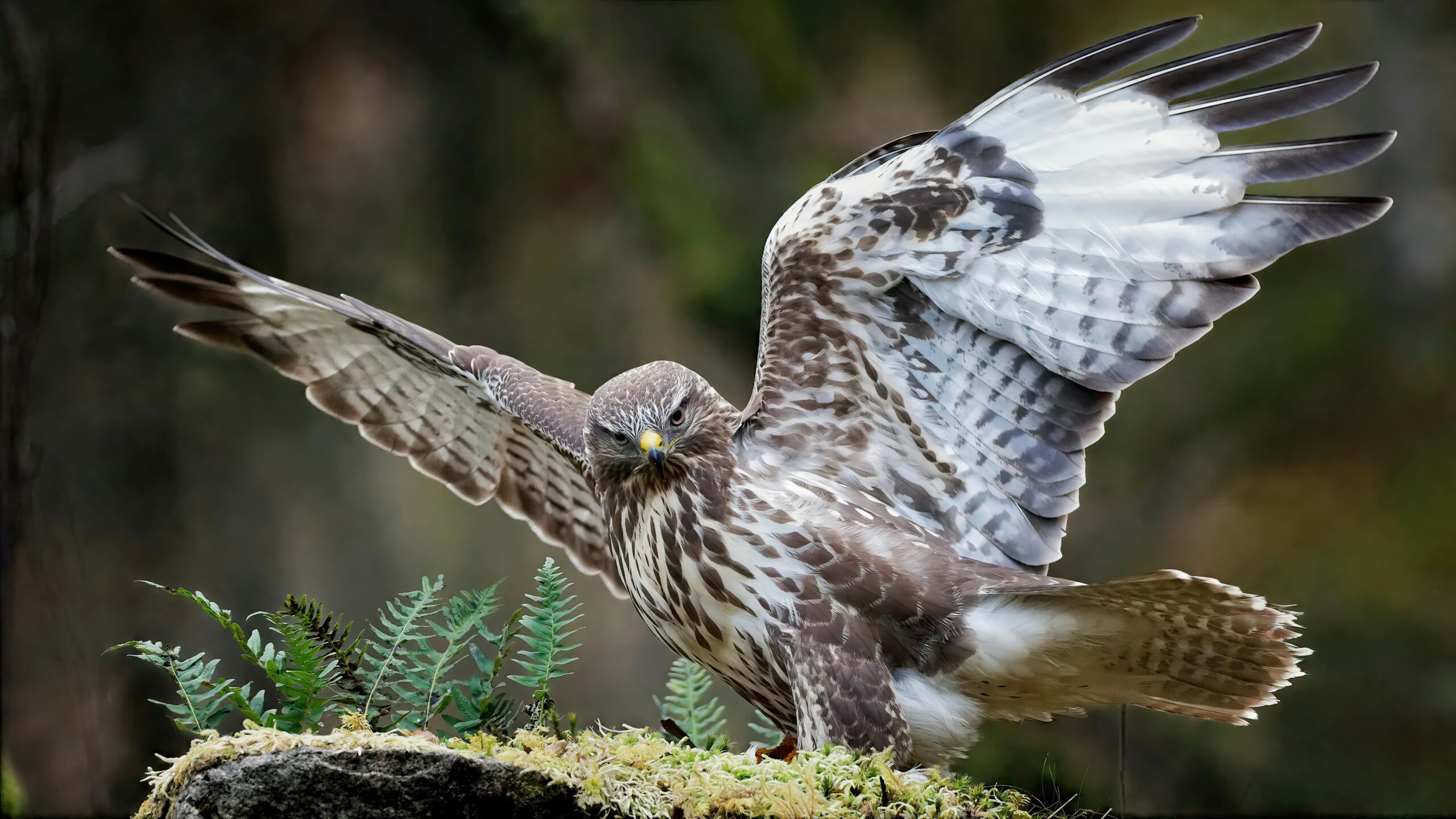The common buzzard (Buteo buteo) is one of the most widespread birds of prey in Europe, known for its adaptability and keen hunting skills. This majestic raptor undergoes a fascinating life cycle, from a fragile egg to a dominant predator soaring in the skies. Each stage of its development is crucial for survival, requiring parental care, learning, and adaptation.
In this article, we will explore the key phases of the common buzzard’s life cycle, including incubation, early development, hunting mastery, and reproduction. Understanding these stages provides insight into how these birds thrive in the wild and maintain stable populations despite environmental challenges.
Egg Stage: The Beginning of Life
The life of a common buzzard begins in the safety of a well-constructed nest. These birds are monogamous and typically return to the same nesting site each year, reinforcing their bond with their mate. Nests are built high in trees or on cliffs, providing protection from predators. Made of sticks and lined with softer materials like leaves and moss, these nests serve as a secure environment for the developing eggs.
A female buzzard usually lays between 2 to 4 eggs, which are oval-shaped and have a distinctive white or bluish tint with brown speckles. The incubation period lasts about 33 to 35 days, with the female primarily responsible for keeping the eggs warm while the male provides food. This stage is crucial, as the embryos develop inside the eggs, relying on stable temperatures and protection from environmental threats such as harsh weather and predators like crows or ravens.
Nesting and Incubation
During incubation, the female remains highly attentive, rarely leaving the nest except to feed quickly. She carefully turns the eggs to ensure even heat distribution, which is essential for proper embryonic growth. The male buzzard plays a supportive role by bringing food and defending the territory from potential threats.
Some key aspects of this phase include:
- Nest selection: Preferred locations are tall trees or rocky ledges, ensuring safety.
- Egg protection: Parents aggressively defend against intruders, using aerial displays and calls to ward off threats.
- Parental cooperation: While the female incubates, the male hunts and provides food.
This period requires patience and vigilance, as the survival of the next generation depends on the dedication of both parents. Once the eggs hatch, the real challenges of raising young buzzards begin.
Hatchling Phase: Early Survival Challenges
Once the common buzzard eggs hatch, the tiny, vulnerable chicks emerge covered in soft white down. These hatchlings are completely dependent on their parents for warmth, protection, and food. During this early stage, survival is uncertain, as competition among siblings can be intense, especially if food is scarce.
Newly hatched buzzards are altricial, meaning they are born with closed eyes and weak muscles, unable to regulate their body temperature or feed themselves. The mother remains in the nest to brood them while the father tirelessly hunts for food. As the days pass, the chicks grow stronger, their eyes open, and they begin to develop better coordination.
Parental Care and Feeding
Parental care is critical for hatchling survival, with the following key behaviors ensuring their growth:
- Frequent feeding: Parents provide a steady supply of small prey, such as rodents, small birds, and insects. The mother tears food into tiny pieces to feed the weakest chick first.
- Siblicide risk: In times of food scarcity, stronger siblings may outcompete or even attack weaker ones. This natural selection process ensures the survival of the fittest.
- Nest hygiene: Parents remove uneaten food and waste from the nest to prevent disease and parasites from spreading.
- Rapid growth: Within two weeks, hatchlings nearly double in size and begin developing stronger features, preparing for the next phase of their life.
During this period, the constant care of the parents is vital. The chicks will continue growing and developing feathers, preparing for their next challenge—learning to hunt and survive on their own.
Juvenile Development: Learning to Hunt
As common buzzard chicks grow, they enter the juvenile stage, marked by rapid physical and behavioral changes. Around three to four weeks old, they begin developing their first feathers, replacing the soft down that initially covered their bodies. This transition is crucial, as strong feathers are essential for flight and hunting.
By six weeks of age, the young buzzards start exercising their wings, flapping vigorously and making short, clumsy hops within the nest. This phase, known as branching, involves the chicks exploring nearby branches and strengthening their muscles in preparation for their first flight.
Growth and Feather Development
The development of flight feathers and overall strength is critical at this stage. Some key aspects include:
- Wing exercises: Juveniles practice flapping and gliding within the nest before attempting their first real flight.
- Parental guidance: Parents continue to provide food but start reducing feedings to encourage self-sufficiency.
- First flights (fledging): Around six to seven weeks old, young buzzards take their first flight, often landing awkwardly and requiring several days to master controlled flight.
- Recognition of prey: Although still dependent on their parents for food, juveniles observe hunting techniques and begin identifying potential prey.
This stage is filled with challenges, as only the strongest and most skilled fledglings will successfully transition into independent hunters. The next phase—adulthood—is where they must prove their ability to survive in the wild.
Adulthood: Mastering the Skies
Once a juvenile buzzard has fully developed its flight skills and hunting abilities, it enters adulthood. This transition typically occurs around one year of age, though full maturity, including the ability to reproduce, is reached at two to three years old. During this period, the young buzzard must establish its own territory, refine its hunting techniques, and avoid threats from larger predators and rival raptors.
Adult buzzards are solitary hunters, often seen soaring at great heights, scanning the ground for movement. Their keen eyesight allows them to spot prey from long distances, and they rely on a combination of stealth and precision to capture food. While they primarily feed on small mammals such as rodents, they are opportunistic hunters and will also consume birds, reptiles, and carrion when available.
Hunting Techniques and Territory Establishment
To survive and thrive, adult buzzards must master several key skills:
- Territory defense: Buzzards are highly territorial and will use aerial displays, loud calls, and even physical combat to defend their hunting grounds.
- Diverse hunting strategies: Depending on their environment, they may hunt from perches, hover in the air, or perform surprise attacks from a high glide.
- Efficient energy use: Unlike falcons, which rely on speed, buzzards use patience and endurance, soaring effortlessly on thermals to conserve energy.
- Adaptability: While they prefer open countryside, buzzards can thrive in forests, farmland, and even near human settlements.
At this stage, the buzzard has fully integrated into its ecosystem, playing a crucial role in maintaining prey populations and balancing the food chain. However, to ensure the continuation of their species, adult buzzards must find a mate and begin the reproductive cycle.
Mating and Reproduction: Continuing the Cycle
As the common buzzard reaches sexual maturity at around two to three years of age, it begins the process of finding a mate and reproducing. These birds are monogamous, often forming long-term pair bonds that can last for many breeding seasons. Courtship displays usually begin in early spring, marked by dramatic aerial acrobatics, soaring flights, and vocal calls to attract a partner.
Once a pair is established, they will work together to select a suitable nesting site. Buzzards prefer high locations such as tall trees, cliffs, or even abandoned nests of other large birds. The pair will reinforce their chosen nest with sticks, leaves, and moss, ensuring a secure environment for their future offspring.
Courtship and Nesting Behavior
During the breeding season, buzzards exhibit several distinct behaviors to ensure reproductive success:
- Aerial courtship displays: Males and females engage in spectacular high-altitude flights, sometimes locking talons mid-air before releasing each other in a dramatic freefall.
- Nest building and maintenance: Both parents contribute to the construction and repair of the nest, reinforcing it with fresh materials each season.
- Egg laying and incubation: The female lays 2 to 4 eggs, which she incubates for about 33 to 35 days, while the male provides food.
- Parental roles: Once the chicks hatch, both parents play crucial roles in feeding, defending, and raising their young.
With successful mating and nesting, the life cycle of the common buzzard continues, ensuring the survival of the next generation. These birds play an essential role in maintaining ecological balance, and their ability to adapt to different environments contributes to their widespread success across Europe and parts of Asia.
Conclusion
The common buzzard follows a remarkable life cycle, transitioning from a fragile egg to a powerful predator soaring through the skies. Each stage—incubation, hatching, juvenile development, adulthood, and reproduction—plays a crucial role in ensuring the survival of the species.
From the moment they hatch, young buzzards face numerous challenges, including competition for food, learning to fly, and developing essential hunting skills. Those that survive into adulthood become skilled hunters, establishing territories and contributing to the delicate balance of their ecosystems. Their monogamous nature and strong parental instincts further ensure the continuation of their lineage.
Despite their adaptability, habitat destruction, poisoning, and human interference pose threats to buzzard populations. Conservation efforts and legal protections in many countries have helped maintain stable numbers, but ongoing awareness is essential to safeguard their future.
By understanding the life cycle of the common buzzard, we gain insight into the resilience and importance of these magnificent birds of prey in the natural world.

